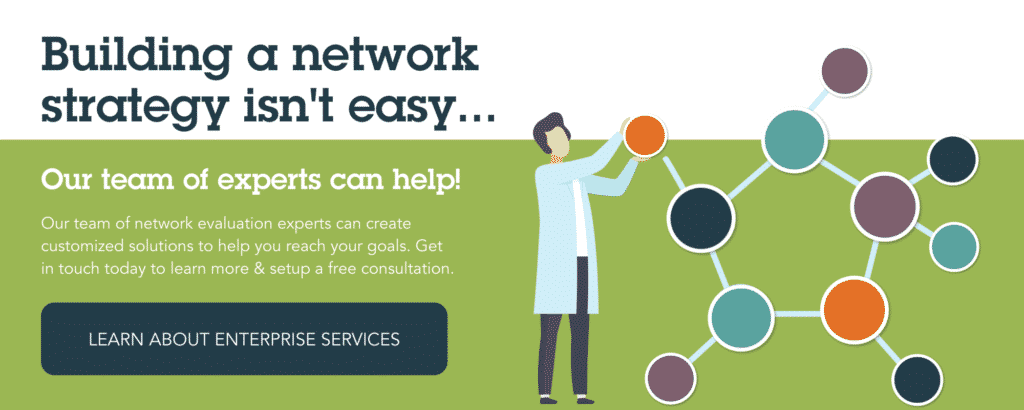Networks are Fluid & Dynamic, So Network Leadership Should Be Too

WHY NETWORK SCIENCE IS SO RELATABLE, AND REALLY FUN
One of the most natural, human feelings is the desire to connect to others. We desire it physically, mentally, and functionally. Yet even our most intuitive selves can get mired in the complexities of how these connections to people, organization, and things play out. Connectivity can be delightful and almost simultaneously confusing or frustrating. And as with all things complex, science holds great promise to understand complex ideas and help us make understanding of our experiences.

Network science is a particularly fascinating science because it is so relatable to our everyday experiences. A science that tends to our curiosities of how things are connected to each other, where patterns exist in those connections, and how they vary and change over time is a science for the human race. In fact, one of my favorite things is to recognize that yes indeed, we are all Network Scientists. We just might not know that yet.
YOU ARE ALREADY USING THE SCIENCE OF NETWORKS IN EVERYDAY LIFE
While network science might be something people can relate to, it doesn’t mean it obvious what it is or how it works. Some of the theory and application is described in this past blog on the Secrets of Network Science, but the real fun part is that we are all using network science in many of the decisions and actions we make every day. For example, a basic network science principle that we should expand our networks, increase our connections to others is a pretty humanistic way of thinking about connectivity. The “more is better” approach works in many situations, for many people. As children, we learned early on that popular kids had more friends and were well connected. Having fewer friends meant you were not as cool.
Many of us have carried this instinct that more connections are better into our adult lives. In this age of the “network way of working”, we tend to let this instinct drive our personal, organizational, even community-wide approaches to building collaboration and connections. Similarly, in the professional world, there is endless advice about the need to go out and network, meet people, and in turn, open opportunities.
While a more is better approach is how we are accustomed to think, the most effective networks and networkers are actually those that take a very different type of network approach. The network science principle that more is not always better speaks to another one of our most basic needs and instincts – to shut down, scale it back when we are overloaded with too many connections. For example, in big crowds. While we like to be around people, almost all of us can relate to the feeling of being too connected, too stimulated, and we need that feeling of detaching, deactivating some of the connectivity. And for us introverts, that happens sooner than for others.
NETWORKS ARE FLUID AND DYNAMIC – SO YOU SHOULD BE TOO
What makes network science so cool is how these basic principles that make it so relatable also emphasize how counter-intuitive and complex building networked connections can be. The reality is, all day long, as you go throughout your day interacting with people in different ways – from simply making eye contact to orchestrating big complex interactions, your brain is triggering all kinds of network science principles which prompt you how to connect with others. A lot of the time this is the reel running in our subconscious and we are not making any deliberate decisions that we notice. But trust me, once you have the network science bug, you will start to notice more and more.

Not an hour of my day goes by when I don’t realize that some tradeoff between more, or less interaction is happening in my world. I admit I am a huge network geek who pretty much has a filter between myself and the world around me that is network mapping the interactions around me all the time, so I get it that most people won’t have the same experience. But once you start thinking about the world from a network science lens, you’ll find you almost cannot NOT see it that way.
“YOU ARE HUMAN, SO YOU SHOULD KNOW HOW TO BUILD RELATIONSHIPS” – OR YOU CAN BUILD SOME SKILLS AND GIVE YOURSELF A HAND.
Where we get network building mostly wrong though, is by stopping at our collective agreement that we “need to collaborate” to make change, impact something, or just get a personal advantage. We get it. Collaboration is not accepted everyone but we are going to take a leap and say that the idea of collaboration, across sectors, or building out your personal network to advance your professional career is normative today. Without also offering tools for how to be a better networker, how to be strategic, and consider a whole bunch of factors that should determine to what level and depth you might want to engage a group of partners, a community of organizations, or just to build up your own professional network.
If building a network was simply about doing “more” of it, well, we really wouldn’t need a science to explain how to go about it. In networking there is an assumption that because we are human, we know how to connect to others, that we can go forth and be good networkers if we just trust our human instinct to connect. But I would argue that good network building is not synonymous with being an extroverted, super friendly, and always active and present person. Rather, it’s about being strategic, using your network science instincts, and making intentional decisions about how you want to grow a network.
NETWORK LEADERSHIP SKILLS AND STRATEGIES CAN TAKE YOUR NETWORKING TO THE NEXT LEVEL
At Visible Network Labs, we call this way of working Network Leadership. Network Leadership is based in network science and is not just for the person in charge of things. Authentic network leadership is a skill that all members of a network should have resources and access to. True network leadership is a reciprocal activity, with all members of the relationships given the space and ability to determine what kind of network way of working is going to make them the most effective. For some, that’s being connected to a lot of others, and for some, it’s just a few relationships.

These values are based in one really important concept – that every network, no matter what level it is, is unique, based in a set of cultural norms, historical facts, and collective expectations that make it different from almost any other networks. For that reason, our guiding seven values provide guidance for Network Leaders, that encourage them to articulate their goals, asses where they are, and then build a strategy to get from where they are to where they want to be – using the methods right for them. We believe there are lessons to be learned by studying and understanding networks (and we’ve published a ton of that work here), but the very nature of a network is dynamic, contextual, and unique. These values honor those characteristic of a network.
VNL’S 7 CORE VALUES OF NETWORK LEADERSHIP:
Inclusiveness: Network leadership is something everyone needs. This is not a model only for backbone/leadership organizations, but is designed to help build network leadership skills of anyone interacting with others. This includes managers, partners, funders, advocates, community organizers, residents, clients, and many other types of people/organizations.
Community and Cultural Sensitivity: Each community is different and each culture has varying ways of communicating and interacting with deep historical roots that put a context around the needs of that particular network. There is no one best approach to Network Leadership. Network Leadership builds skills and capacity in order to empower network leaders/members to adapt them to their context, culture, and community.
Relationship Focused: At the heart of Network Leadership is the concepts of interaction, relationships, systems building, and partnerships. Almost everyone is being asked to work across sectors in partnership with others in networks (referred to by many different names such as coalitions, partnerships, collaboratives, and collective impacts) in turn bridging across boundaries and interacting with both the usual and unusual suspects. Network Leadership focuses on ways that people, communities, and organizations interact and how relationships among and within relationships affect one another and their related outcomes.
Skills Based: Network leadership is focused on skills, not a prescribed list of “must do’s, rules, or expectations”. Rather developing a set of skills that are customized for the population and community that a network leader is working in will ensure that context and cultural differences are honored.
Data Driven: Network leaders can manage and nurture relationships, but they need data to do it. Network leadership demonstrates how to build an evidence base by collecting and using many different kinds of data to make decisions. Data can be qualitative or quantitative, but the practice of making evidence-based, informed decisions, rather than trusting one’s “gut” is a key characteristic of a network leader.
Reflective: With data and experience, Network Leaders practice reflection in collaboration with partners, stakeholders, and communities to determine action steps and strategies. Diverse and inclusive voice is an essential piece of reflection as the network evolves. Network leaders should be agile in their reflection and open to shifts and change based on the feedback.
Adaptive: Network leaders use reflection to adapt their leadership practice. Many types of data are used to inform thinking and decision-making, and an openness to adapt to the learning and continuously iterate on the “solution” is a key component to network leadership.
DO YOU HAVE THE NETWORK SCIENCE BUG? WE HAVE A HOME FOR YOU!
We believe that Network Leadership is a way of leading, not a prescribed set of rules to follow. However, we do find that grounded Network Leadership in network science has been a guiding way for us to develop curriculum and agendas that will support people doing the work. If you have the network bug, are intrigued by network science and how it can fit into your workflow, or if you want to expand your circle of learning around Network Leadership, well we have a home for you! At Visible Network Labs, we host workshops and trainings designed to bring together people just like you to learn from each other, and to learn from the foremost thinkers in the field. You can join our annual Network Leadership Training Academy, or any one of our 2 day workshops, our monthly webinar series, or ongoing skill building workshops. Or join our community forum, where fellow network geeks like to congregate and talk shop.





